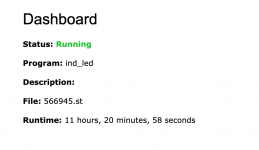Strange, my pi zero is still working.
The code for all our cards are located in OpenPLC_v3/webserver/core/hardware_layers/sequent.cpp, any opinion is welcomed.
I was commented out the line 970 to 973 to force update the LED's on each interval.
The code for all our cards are located in OpenPLC_v3/webserver/core/hardware_layers/sequent.cpp, any opinion is welcomed.
I was commented out the line 970 to 973 to force update the LED's on each interval.

